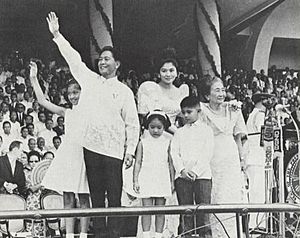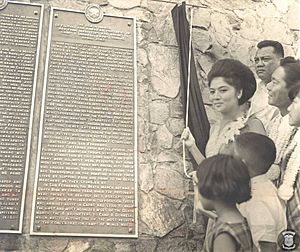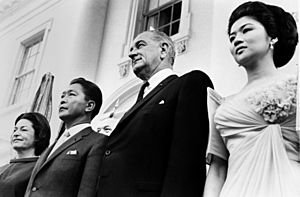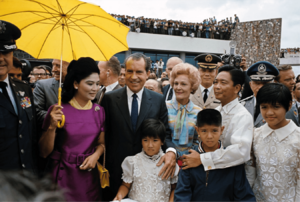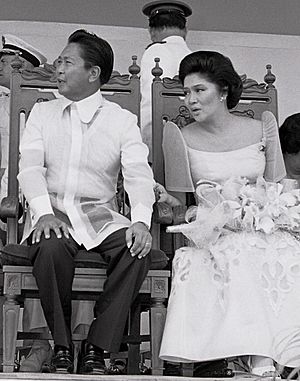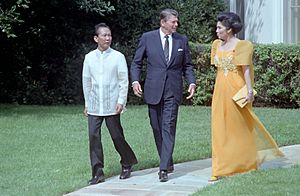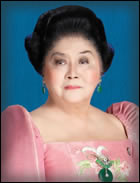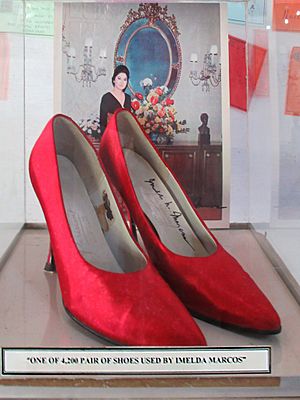Imelda Marcos facts for kids
Quick facts for kids
Imelda Marcos
|
|
|---|---|

Marcos in 1973
|
|
| Member of the Philippine House of Representatives | |
| In office June 30, 2010 – June 30, 2019 |
|
| Preceded by | Bongbong Marcos |
| Succeeded by | Eugenio Angelo Barba |
| Constituency | 2nd District of Ilocos Norte |
| In office June 30, 1995 – June 30, 1998 |
|
| Preceded by | Cirilo Roy Montejo |
| Succeeded by | Alfred Romualdez |
| Constituency | 1st District of Leyte |
| Member of Parliament for Region IV (Metro Manila) | |
| In office June 12, 1978 – June 5, 1984 |
|
| Governor of Metro Manila | |
| In office February 27, 1975 – February 25, 1986 |
|
| Appointed by | Ferdinand Marcos |
| Vice Governor | Mel Mathay (1979–1986) |
| Preceded by | Office established |
| Succeeded by | Joey Lina (OIC) |
| Minister of Human Settlements | |
| In office June 12, 1978 – February 25, 1986 |
|
| President | Ferdinand Marcos |
| Preceded by | Office established |
| Succeeded by | Office abolished |
| First Lady of the Philippines | |
| In role December 30, 1965 – February 25, 1986 |
|
| President | Ferdinand Marcos |
| Preceded by | Eva Macapagal |
| Succeeded by | Amelita Ramos (1992) |
| Personal details | |
| Born |
Imelda Remedios Visitación Trinidad Romuáldez
July 2, 1929 San Miguel, Manila, Philippines |
| Political party | Nacionalista (1965–1978; 2009–present) |
| Other political affiliations |
Kilusang Bagong Lipunan (1978–2015) |
| Spouses | |
| Children | Imee Marcos Bongbong Marcos Irene Marcos Aimee Marcos (adopted) |
| Criminal status | Released on bail pending appeal |
| Conviction(s) | 7 counts of Graft under the Section 3(h) of the Anti-Graft and Corrupt Practices Act |
| Criminal penalty | 6 years and 1 month–11 years of imprisonment Suspension from holding public office |
| Residences | Makati, Metro Manila |
Imelda Romuáldez Marcos (Tagalog pronunciation: [ɪˈmelda ˈmaɾkɔs]; born Imelda Remedios Visitación Trinidad Romuáldez; July 2, 1929) is a Filipino politician who was First Lady of the Philippines from 1965 to 1986, wielding significant political power after her husband Ferdinand Marcos placed the country under martial law in September 1972. She is the mother of current president Bongbong Marcos.
During her husband's 21-year rule, Imelda Marcos ordered the construction of many grandiose architectural projects, using public funds and "in impossibly short order" – a propaganda practice, which eventually came to be known as her "edifice complex". She and her husband stole billions of pesos from the Filipino people, amassing a personal fortune estimated to have been worth US$5 billion to US$10 billion by the time they were deposed in 1986; by 2018, about $3.6 billion of this had been recovered by the Philippine government, either through compromise deals or sequestration cases.
Marcos and her family gained notoriety for living a lavish lifestyle during a period of economic crisis and civil unrest in the country. She spent much of her time abroad on state visits, extravagant parties, and shopping sprees, and spent much of the State's money on her personal art, jewelry and shoe collections – amassing 3,000 pairs of shoes. The subject of dozens of court cases around the world, she was eventually convicted of corruption charges in 2018 for her activities during her term as governor of Metro Manila; the case is under appeal. She and her husband hold the Guinness World Record for the "Greatest Robbery of a Government", putting Suharto of neighboring Indonesia at second.
The People Power Revolution in February 1986 unseated the Marcoses and forced the family into exile in Hawaii. In 1991, President Corazon Aquino allowed the Marcos family to return to the Philippines to face various charges after the 1989 death of Ferdinand. Imelda Marcos was elected four times to the House of Representatives of the Philippines, and ran twice for the presidency of the Philippines but failed to garner enough votes.
Early life
Imelda Remedios Visitación Romuáldez was born at dawn in San Miguel, Manila, on July 2, 1929. Her parents were Vicente Orestes Romuáldez, a lawyer, and his second wife, Remedios Trinidad. Imelda is the sixth of Vicente's eleven children, and Remedios's firstborn.
Born into the Romuáldez political dynasty from the province of Leyte, Imelda grew up in a wealthy clan of devout Catholics. She was baptized in the nearby San Miguel Church on the day after her birth.
Notable members of Imelda's family include the clan matriarch Doña Trinidad López de Romuáldez; her uncle Norberto Romuáldez, who was a Supreme Court Associate Justice; and her younger brother Benjamin "Kokoy" Romuáldez, who served as Governor of Leyte and later as an ambassador under the regime of Imelda's husband, Ferdinand Marcos.
At the time of her birth, the Romualdezes were wealthy. Around 1932, the financial conditions of Imelda's family began to decline.
Imelda's parents were separated for a time, during which Remedios worked for the nuns at the Asilo de San Vicente de Paul. Vicente and Remedios eventually reconciled but to avoid further conflict, she and her children, including Imelda, moved to their house's garage. In 1937 after Conchita's birth, Remedios's health began to fail and she died on April 7, 1938, due to double pneumonia. In her ten years of marriage, Remedios had six children – Imelda, Benjamin, Alita, Alfredo, Armando and Conchita.
In the same year, 1938, Imelda's father gave up Manila due to his declining fortunes in his law practice and returned to Tacloban where he could support his family with a simpler lifestyle. She grew up learning the Waray language, and then learned the Tagalog language and, eventually, English.
Education
Elementary
Imelda finished grade one in the nearby College of the Holy Spirit Manila, where her older half-sisters also studied.
She continued her early studies at Holy Infant Academy, a convent school run by Order of Saint Benedict. The old wooden structure of the school still stands today four blocks away from the Romualdez house. At school, Imelda had to face her family's humiliating poverty, and she was frequently among the students who had to apologize for late payments.
High school
In 1942, the Romualdezes returned to Tacloban, and around that time, Imelda's father refused to let her go back to school. When the Americans returned in 1944, she was eager to resume her studies at Leyte Progressive High School. She finished her first year at the provincial high school where she was also chosen Miss I-A; then in her second year, she moved to Holy Infant and stayed there until she graduated.
Imelda continued her higher studies at Holy Infant Academy from 1938 to 1948, the year she graduated from high school. As a student, her scholastic record shows that she had a general average of 80 percent throughout her primary and high school.
College
Imelda ran for President of the student council at St. Paul's College (now named Divine Word University) in 1951, three years before her marriage to Marcos. At that time, she was about to graduate with a degree in Education. She was put up as candidate for the Department of Education, which had an enrollment of 800 students. Even during the nomination, her victory was already a foregone conclusion, but the school authorities insisted that another candidate be put up to make the elections a democratic procedure. That was how the College of Law, with 200 students, put up Francisco Pedrosa.
While an undergraduate student, Marcos taught at a local Chinese high school before graduating in 1952. She had won a scholarship to study music at the Philippine Women's University under Adoración Reyes, a close friend of the family. She briefly held a job at a music store but left this for a better one at the Central Bank. After a few lessons, Adoración was convinced that Imelda had talent and persuaded her to enroll at the College of Music and Fine Arts at PWU, under a special arrangement that put her on register while Adoración continued to give her free lessons.
Early career
Imelda returned to Manila in 1952 under the rule of President Elpidio Quirino and stayed in the house of her relative, House of Representatives of the Philippines Speaker Pro tempore Daniel Romuáldez, who had three adopted children. Imelda's status in the Romuáldez household during this time has been described as "higher than servants and lower than family members as a poor relative". Imelda found work as a salesgirl in a store called P.E. Domingo, which infuriated her father when he learnt of during one of his visits, perceiving it as ill treatment of Imelda.
To calm the indignation of Vicente Romuáldez, Eduardo and Daniel exercised their political and economic influence to find work for Imelda in the Central Bank where she worked under Braulio Hipuna, the Chief Clerk of the Intelligence Division.
During this time her cousin Loreto Ramos introduced her to Adoración Reyes, a teacher from the College of Music and Fine Arts of Philippine Women's University (PWU), who gave her vocal lessons and a chance to get a PWU scholarship. She later sang three songs at a performance with her cousin Loreto at Holy Ghost College (now named College of the Holy Spirit Manila).
Imelda also joined the 1953 Miss Manila beauty pageant. The results became controversial, resulting in both Imelda and Miss Norma Jiménez being declared Manila's candidate to the larger Miss Philippines pageant. Both of them eventually lost to Miss Cristina Galang.
Courtship and marriage
Imelda and Ferdinand Marcos met on April 6, 1954, during a budget hearing at the Philippine Congress. Ferdinand was part of the opposition team who led the argument against the budget, while Imelda was there to visit her cousin Daniel, who was the Speaker of the House. During a recess, Imelda caught Ferdinand's eye, and he asked his journalist friend Jose Guevara of The Manila Times to introduce him to Imelda. At that time, Ferdinand already knew of Imelda. Imelda, on the other hand, knew very little of Ferdinand Marcos. After comparing heights and confirming that he was at least an inch taller than her, Ferdinand sought the help of Guevara to pursue Imelda in marriage. This whirlwind courtship lasted only eleven days.
During Holy Week of that year, Ferdinand visited Imelda's house, and when Imelda claimed that she planned to spend the holidays in Baguio, Ferdinand and Guevara offered her a ride up to Daniel's family mansion where she planned to stay, while the two booked a room in nearby Pines. For the remainder of that Holy Week, Ferdinand showered Imelda with flowers and gifts and visited her daily, prodding her to sign the marriage license that sealed the agreement. On April 16, 1954, Good Friday, after having been jokingly asked by Guevara if she wanted to be "the First Lady of the Land someday", Imelda finally agreed to sign it. On April 17, 1954, Ferdinand and Imelda were secretly married by a reluctant Francisco Chanco, a judge befriended by Ferdinand who lived in the area. The church wedding followed only after receiving the blessing of Vicente Orestes, Imelda's father, which Ferdinand asked via telegram on Easter Sunday. Their wedding was held on May 1, 1954, at the San Miguel Pro-Cathedral in Manila where Imelda was christened.
The marriage meant that Ferdinand's common-law wife, Carmen Ortega of La Union's Ortega political clan, with whom he had already sired three children, had to be quietly taken out of the public eye.
1965 presidential campaign
It was during the 1965 campaign that Imelda became influential as a political figure at the national level, supporting her husband’s political tactics through her charismatic appeal and youth. Crowds of working class Filipinos came out in droves to Marcos campaigns because they wanted to see the "beautiful wife of Marcos".
Campaign strategists incorporated Imelda’s public appeal into the overall tone of the Marcos-led Nacionalista campaign, asking Imelda to always appear at her best in public at all times regardless of the type of audience and encouraging her to wear her signature ternos as an integral part of their image strategy.
Marcos heavily relied on Imelda, eventually telling the press at one point that it was Imelda who had delivered the one million vote margin he needed to win the election.
It was in this period that Imelda described herself – a neophyte transitioning into a true political partner to her husband – as "a butterfly breaking out of its cocoon". This led one foreign journalist to call her "the iron butterfly".
Imelda had assumed a managerial position in her husband's campaign early on, when Marcos faced his first challenge of the campaign, which was to win the presidential candidacy for the Nacionalista Party. She enthusiastically ran a detailed campaign, befriending the 1,347 delegates of the Nacionalista Party Convention until Ferdinand Marcos won the party’s presidential nomination on November 21, 1964, for the Nacionalista Party.
McCoy recounts that it was supposedly also Imelda who convinced Fernando Lopez to accept the vice-presidential nomination alongside Marcos. She met Lopez personally, appealing to him by recounting the many struggles she and Ferdinand faced during the campaign. Lopez refused to give in multiple times, until Imelda cried in front of him. When he relented, Imelda proceeded to hand a document to sign, stating that he had accepted the nomination as the Nacionalista vice-presidential candidate.
During the presidential election itself, she delivered votes from the southern province of Leyte and Manila. She was especially popular with the poor. Imelda also used her voice to appeal to voters, singing during campaigns. Her songs were usually varieties of local folk songs.
First term (1965–1969)
Imelda began Ferdinand Marcos's first term doing the duties traditionally expected of a First Lady, mostly social events and public appearances. Imelda became a power broker. Receptions at her offices in the Malacañang "Music Room" were sought after by cabinet members, heads of financing institutions, and business leaders who felt that she had Ferdinand's ear.
A year later in March 1966, Marcos established the Cultural Center of the Philippines through Executive Order No. 60 and arranged for Imelda to be elected chairman of the board in a bid to change the perception that she was just another "politician's wife".
Inauguration
Ferdinand Marcos was elected as the 10th president of the Philippines on November 9, 1965. When he was inaugurated on December 30, 1965, Imelda officially became the First Lady.
The Romualdez clan had been torn apart by the presidential campaign. To fix this, Imelda allegedly sent out invitations to family members, some of whom supported the opposing party, and told them they were all welcome at their house on Ortega Street, San Juan, Metro Manila.
Ferdinand and Imelda held mass in the courtyard of their house on Ortega Street before proceeding to Luneta Park for the inauguration ceremonies.
At night, a state dinner hosted 60 guests in the reception hall of the Malacañang Palace.
Early projects
In the first three years of being First Lady, she spent PHP 1 million for the beautification of the Paco Park and 24 million for the beautification of Fort Santiago.
In May 1966, Imelda pushed a twelve million peso plan to pool together the social welfare efforts of several dozen social welfare groups. The plan involved the construction of welfare villages and the reorientation of personnel to staff them. The cornerstone for first village, the Reception and Study Center in Quezon City was laid in 1966, and several more were built from then until 1968: Marilla Hills in Alabang, the Children's Orphanage in Pasay, the Molave Village in Tanay, Rizal, a Home for the Aged in Quezon City, and the Philippine Village at the Manila International Airport.
In mid-1967, Imelda started the "Share for Progress" Seed Dispersal Program a project that suggested making vegetable gardens out of idle lots all over the country. By 1968, 309,392 kits containing seeds had been distributed in over 1500 towns.
Blue Ladies
The "Blue Ladies", a group initially composed of wives of political men in the Nacionalista Party, had played a critical role during Marcos's 1965 campaign. They contributed funds and provided publicity, giving the campaign a personal touch by visiting factories and farms to shake hands and have small conversations with the voters, making door-to-door appeals in the slum areas. That year they also introduced to politics the purchase of radio and television time, to campaign for Marcos, through the use of little speeches for the voters. This was affordable because the Blue Ladies were mostly prominent matrons and/or beautiful youthful girls married to men of means.
Upon becoming First Lady, Imelda often asked members of the Blue Ladies to accompany her on her trips out of the country. One of her most famous socialite friends was Cristina Ford.
Imelda's Blue Ladies—specifically Maria Luisa, a daughter of the rich Madrigal family and the wife of Daniel Vazquez—contributed to the fashion spending of Imelda. In 1968, Maria Luisa accompanied Imelda on an overseas trip, during which Imelda and daughter Imee spent $3.3 million. At this time Vazquez and Maria Luisa opened a Citibank account. In November 1968, the couple added "Fernanda Vazquez" as a joint holder of the bank account. An allegation that Imelda and Fernanda Vazquez are one and the same is validated by the notations for the bank account had Imelda Marcos's handwriting.
Beatles incident
On July 4, 1966, the First Lady also invited the Beatles to perform at a private event in the Palace but the invitation was declined. An order to lock down the Manila International Airport was enacted as a result of the rejection. This resulted in mobs trying to storm the band's hotel rooms and prevent them from leaving the country. There were also reports that a PHP 100,000 tax assessment was issued to their manager.
After 1968 Imelda began gaining more and more political power. She had free rein on her projects while her husband prepared for the Ferdinand Marcos presidential campaign, 1969, but as Marcos's health declined, it involved her being put in increasingly powerful positions, including those of Minister of Human Settlements and of Governor of Metro Manila.
Second term (1969–1972)
In July 1974, the annual Ms. Universe pageant was held in Manila, to which then First Lady Imelda Marcos allegedly spent PHP 40 million (USD 5.5 million) for the renovation of all public and private infrastructures throughout Manila, and the other cities in which the Ms. Universe pageant participants were subsequently toured.
Foreign relations roles
Since the President hardly left the Malacañang Palace, Ferdinand increasingly sent his wife on official visits to other countries as a de facto vice president.
When the Marcoses went to the United States in September 1966, President Lyndon B. Johnson offered Imelda the Philippine war damage claims totaling US$28 million. President Johnson agreed to have US$3.5 million be used as funds for the Cultural Center, one of Imelda's projects.
For the inauguration of the CCP, a gala opening of the Golden Salakot, a pageant-drama of a story about the prehistory of the Philippines, occurred on September 8, 1969. US President Richard Nixon was invited but instead California Governor (and future President) Ronald Reagan, along with his wife, flew to the country on Air Force One for the event. There were accounts that the First Lady attempted to bring other celebrities by getting them tickets to ride Air Force One but she was denied this luxury by President Nixon. Accounts have also mentioned that this trip by the then-Governor Reagan and his wife led to the closeness of the Reagans and Marcoses.
In 1971, Imelda attended Iran's 2,500 year celebration of the Persian Empire of the founding of the Persian Empire. This trip, according to palace insiders, provided her with a social introduction to some of the world's wealthiest people.
Martial law (1972–1981)
During this time period, she orchestrated public events using national funds to bolster her and her husband's image. She secured the Miss Universe 1974 pageant in Manila, which required the construction of the Folk Arts Theater in less than three months. She organized the Kasaysayan ng Lahi, a festival showcasing Philippine history. She also initiated social programs, such as the Green Revolution, which was intended to address hunger by encouraging the people to plant produce in household gardens, and created a national family-planning program. In 1972, she took control of the distribution of a bread ration called Nutribun, which actually came from the United States Agency for International Development (USAID). An assassination attempt against Imelda Marcos occurred on December 7, 1972. The motive appeared to have been her role in her husband's presidency but human rights dissidents believed it was staged by the government.
Foreign relations roles
In 1972, Imelda Marcos initiated the first of many trips to the Soviet Union; it was dubbed as "cultural missions" but eventually led to the establishment of diplomatic relations between the Soviet Union and the Philippines.
In 1975, after the assassination of King Faisal of Saudi Arabia, Marcos wanted to extend the official condolences. Women were not welcome in the Saudi court, but Imelda, through her connection to the surgeon who previously performed a heart surgery on the new king, managed to be the first woman guest to be honored.
In 1978, she was also appointed as Ambassador Plenipotentiary and Extraordinary, allowing her to tour the United States, the Soviet Union, Yugoslavia, and Cuba. Throughout her travels, she became friends with Richard Nixon, Muammar Gaddafi, Saddam Hussein, Fidel Castro, and Joseph Tito. She traveled to Iraq to secure oil and to Libya for a peace treaty with the Moro National Liberation Front.
Governor of Metro Manila
In 1975, Ferdinand Marcos issued Presidential Decree 824, establishing the Metro Manila Commission (MMC), the central government of Metro Manila, and named Imelda to head it, making her Governor of Metro Manila from that point until the Marcoses were deposed in 1986.
Minister of Human Settlements
Ferdinand Marcos appointed Imelda to the position of Minister of Human Settlements in 1976—a post which she held until the EDSA Revolution of February 1986, and which allowed her to construct the Cultural Center of the Philippines, the Philippine Heart Center, the Lung Center of the Philippines, the Philippine International Convention Center, the Coconut Palace, the Manila Film Center, and the Calauit Safari Park.
Batasan Pambansa
In 1978, the administration Kilusang Bagong Lipunan party fielded Imelda as a candidate in the Philippine parliamentary elections of 1978. Because most of the opposition candidates were either in jail or had limited mobility as a result of Martial Law, Imelda Marcos easily won a seat as a member of the Interim Batasang Pambansa (National Congress) representing Region IV (Metro Manila).
Downfall
On February 7, 1986, snap elections were held between Ferdinand Marcos and Corazon Aquino, the widow of Benigno Aquino Jr. Despite Ferdinand Marcos claiming to have won the election, allegations of vote rigging led to mass protests, later known as the People Power Revolution.
On February 25, Ferdinand Marcos, with his wife Imelda by his side, held the inauguration at Malacañang Palace. The couple later emerged on the Palace balcony in front of a loyalist crowd and Imelda sang a song for the crowd.
Later that day, Ferdinand Marcos finally agreed to step down and was given safe passage for him and his entire family to flee to Hawaii, United States.
Exile in Hawaii (1986–1991)
At midnight, February 26, 1986, the Marcos family fled the country to Hawaii with a party of about 80 individuals – the extended Marcos family and a number of close associates. Their arrival was controversial, and soon led to Hawaii residents calling on the government to force the Marcoses to leave.
The US Government initially hosted the exiles at Hickam Air Force Base. Ferdinand and Imelda moved into a pair of residences in Makiki Heights, Honolulu, a month later.
Ferdinand Marcos eventually died in exile in September 1989. His son Bongbong Marcos was the only family member present at his deathbed.
After Imelda left Malacañang Palace, press reports worldwide took note of her lavish wardrobe, said to include 15 mink coats, 508 gowns, 888 handbags, and 3,000 pairs of shoes. Some news reports estimated that there were up to 7,500 pairs, but Time magazine reported that the final tally was 1,060. The US government documented that the Marcos family entered the United States with millions of dollars in cash, stocks, jewelry, and gold kilobars inscribed "To my husband on our 24th anniversary".
Return from exile (1991–present)
On November 4, 1991, President Corazon Aquino allowed Imelda and her children to return to the Philippines so they could be formally charged in their tax fraud and corruption cases - part of the government's effort to convince Swiss courts to return the money in the Marcos' Swiss Bank accounts to the Philippine government.
After her return from exile, Imelda returned to politics.
In 1992, Imelda ran for president in the 1992 Philippine presidential election, finishing 5th out of 7 candidates.
She was elected as a congresswoman of Leyte during the 1995 Philippine general election, representing the first district, despite facing a disqualification lawsuit in which the Supreme Court ruled in her favor.
She chose not to seek re-election in Congress and instead sought the presidency again in the 1998 Philippine presidential election, but later withdrew to support the eventual winner Joseph Estrada ,while she finished 9th among 11 candidates. She considered running for mayor of Manila in the 2001 Philippine general election but did not push through with it.
In November 2006, Marcos started her own business, a fashion label "Imelda Collection" including jewelry, clothing and shoes with the help of her daughter Imee.
Imelda ran for the second district of Ilocos Norte in the 2010 Philippine House of Representatives elections to replace her son, Ferdinand Jr. (Bongbong), who ran for senator under the Nacionalista Party. During her term, she held the position of Millennium Development Goals committee chair in the Lower House.
She was re-elected on May 14, 2013, and on May 9, 2016, for a third and final term.
In October 2018, Marcos filed her certificate of candidacy to run for governor of Ilocos Norte in the 2019 Philippine general election to replace her daughter, Imee, who was term-limited and chose to run for senator. However, following her conviction of graft, she withdrew from the race a month later and was substituted by her grandson Matthew Manotoc, initially her running mate for vice governor. Manotoc eventually won the gubernatorial race.
Marcos underwent a successful angioplasty at St. Luke's Medical Center – Global City, Taguig on May 7, 2023. She was hospitalized in March 2024 after contracting a suspected case of pneumonia.
Cultural influence
"Imeldific"
In the late 1980s, the revelation that Imelda Marcos had "amassed a huge collection of art, jewellery, property and – most famously – at least 1,000 pairs of shoes", had turned her into a household name, frequently compared to Marie Antoinette of France, except "with shoes".
It also refers to people who have "the Imelda Marcos syndrome" – tending to be extravagant and not being afraid to flaunt it, or to describe a lifestyle of "ostentatious extravagance".
It has also come to be used in International English, with dictionary writer and Atlantic columnist Anne Soukhanov expounding on the "ostentatious extravagance" etymology. In popular international media, the Sydney Morning Herald's Jackie Dent said it simply "means to be ... well, like Imelda".
Fashion
Marcos influenced fashion in the Philippines, although her role as a patroness of the arts and fashion is still controversial. For instance, she actively promoted the terno, which also became her sartorial symbol, through projects such as "Bagong Anyo" and exhibitions abroad such as the Philippine contribution to the Expo '75 in Okinawa Japan.
Imelda made a conscious effort to portray herself as a patron of the arts, including those who specialize in Filipino haute couture such as Pitoy Moreno and Inno Sotto.
In a section of the 2003 Ramona Diaz film named after her, Imelda says that she maintains her extravagant clothing because it "inspired the poor to dress better".
Portrayals in news and art
In August 2019, writer/director Lauren Greenfield debuted her documentary film The Kingmaker at the 76th Venice Film Festival, after which it premiered at the Telluride Film Festival, the Toronto International Film Festival, and the London Film Festival, the first documentary to ever debut at all four festivals in the same year. The documentary features the political career of Imelda Marcos with a focus on the Marcos family's efforts to rehabilitate the family's image and to return to political power – including her plans to see her son Bongbong become Vice President of the Philippines. It has a 97% fresh rating from Rotten Tomatoes and a 76/100 from Metacritic.
In the late 1990s, Imelda Marcos agreed to be the subject of a television documentary episode for PBS's Independent Lens, simply titled Imelda, by Ramona S. Diaz. Released in 2003, the film documents her marriage to future President of the Philippines Ferdinand Marcos, her rule under the dictatorship, her exile in Hawaii and her eventual return to the Philippines. Imelda had its world premiere at the International Documentary Film Festival Amsterdam and its North American premiere in the documentary competition of the 2004 Sundance Film Festival, where it won the Excellence in Cinematography Award Documentary. The film was also screened at the Maryland Film Festival in Baltimore. It has a 94% fresh rating from Rotten Tomatoes and a 69/100 from Metacritic. Imelda Marcos obtained a temporary injunction that prevented the film from being shown in the Philippines for a brief time. When the injunction was canceled and the film was released, it earned more than Spider-Man 2 and was considered a hit.
The villain character "Madame" in the popular Filipino Comic Book series Trese is known for being a visual reference to Marcos, with her coiffed hair, butterfly sleeves, and deep connections to the powerful figures of the Trese universe.
The second track of Mark Knopfler's 1996 album Golden Heart is a sardonic song about her. In 2010, British producer Fatboy Slim and musician David Byrne released a concept album about her life called Here Lies Love, which later became a rock musical of the same name.
In Manila, local performance artist Carlos Celdran became known for his Living La Vida Imelda walking tour, which was also performed in Dubai in 2012. Filipino-American drag artist Manila Luzon impersonated Mrs. Marcos in the "Snatch Game" challenge in the third season of RuPaul's Drag Race, deriving humor from the First Lady's renowned obsession with shoes. Hawaiian comedian Frank De Lima has impersonated her on various occasions.
In an episode of Saturday Night Live (aired October 8, 1988), she was portrayed by comedienne Nora Dunn during the segment Weekend Update. She was also portrayed by Clavel Bendaña on the 2003 film Chavit (film).
She is also portrayed by actress Dimples Romana Marcos on the Maalaala Mo Kaya episode entitled Makinilya, the second of the two-part "The Ninoy & Cory Aquino Story" aired on ABS-CBN in 2010. Actress Ruffa Gutierrez also portrayed her in the 2022 film Maid in Malacañang and its sequel, the 2023 film Martyr or Murderer; actress Cindy Miranda portrays the young Marcos in the latter.
She is frequently mentioned in the following Netflix shows like Russian Doll (episode: "Coney Island Baby"), The Crown (episode: "Fairytale") and Dynasty (episode: "A Litte Father-Daughter Chat").
An original musical, Here Lies Love, by David Byrne and Fatboy Slim, spans her life from childhood to exile and utilizes largely disco and club music and innovative immersive staging. The title is a direct reference to a phrase Imelda mentioned she wanted written on her tombstone. Originally conceived as a song cycle, it was presented in concert (Adelaide 2006, Carnegie Hall 2007) format and presented at Mass MoCA (2012) and Off-Broadway (2013, 2014-15) at the Public Theatre. The Broadway transfer began previews at the Broadway Theatre on June 17, 2023, with opening night on July 20, 2023 and closed in the same year on November 26.
Honors
 Japan: Grand Cordon (Paulownia) of the Order of the Precious Crown
Japan: Grand Cordon (Paulownia) of the Order of the Precious Crown
| Honorary titles | ||
|---|---|---|
| Preceded by Eva Macapagal |
First Lady of the Philippines 1965–1986 |
Succeeded by Amelita Ramos |
See also
 In Spanish: Imelda Marcos para niños
In Spanish: Imelda Marcos para niños



